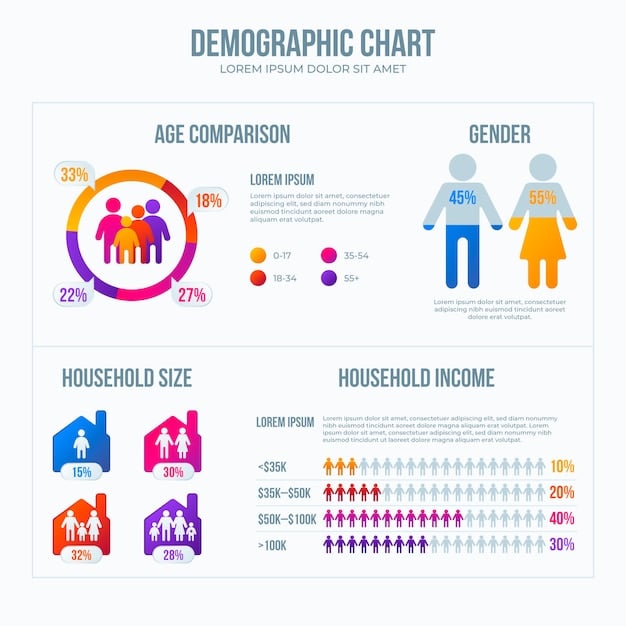Maximize Your HSA in 2025: A Tax-Advantaged Healthcare Guide

Maximize Your Health Savings Account (HSA) in 2025 by understanding contribution limits, tax advantages, investment strategies, and qualified medical expenses for tax-advantaged healthcare planning.
Discover how to Maximize Your Health Savings Account (HSA) in 2025: A Guide to Tax-Advantaged Healthcare. An HSA can be a powerful tool for managing healthcare expenses and securing your financial future.
Understanding Health Savings Accounts (HSAs)
A Health Savings Account (HSA) is a tax-advantaged savings account that can be used for healthcare expenses. HSAs are available to individuals and families who have a High-Deductible Health Plan (HDHP). Understanding the ins and outs of HSAs is crucial for effectively managing healthcare costs and maximizing savings.
What is a High-Deductible Health Plan (HDHP)?
Before diving deeper into HSAs, it’s essential to understand what constitutes a High-Deductible Health Plan (HDHP). An HDHP is a health insurance plan with a higher annual deductible than traditional health plans.
- Minimum Deductible: For 2025, an HDHP must have a minimum annual deductible of at least $1,600 for individuals and $3,200 for families.
- Maximum Out-of-Pocket Expenses: The maximum out-of-pocket expenses, including deductibles, copayments, and coinsurance, cannot exceed $8,050 for individuals and $16,100 for families.
- Preventive Care: HDHPs must cover preventive care services without cost-sharing, meaning enrollees don’t have to pay a deductible, copayment, or coinsurance for these services.
Qualifying for an HSA requires enrollment in an HDHP. Understanding the specifics of HDHPs is the first step in leveraging the benefits of an HSA.
Key Benefits of an HSA
Health Savings Accounts offer a unique combination of tax advantages that can significantly enhance your financial well-being. These benefits make HSAs a powerful tool for managing healthcare costs.
- Tax-Deductible Contributions: Contributions to an HSA are tax-deductible, reducing your taxable income.
- Tax-Free Growth: The money in your HSA grows tax-free. Investment earnings and interest are not taxed.
- Tax-Free Withdrawals: Withdrawals for qualified medical expenses are tax-free, making it an ideal way to pay for healthcare costs.
HSAs provide a triple tax advantage, making them a compelling option for those eligible. Take advantage of these benefits to optimize your healthcare savings strategy.
In conclusion, understanding the basics of Health Savings Accounts and High-Deductible Health Plans is critical for taking full advantage of the tax benefits and savings opportunities they offer. Keep these points in mind as we explore how to maximize your HSA in 2025.
2025 HSA Contribution Limits and Guidelines
Staying informed about the Health Savings Account (HSA) contribution limits and guidelines for 2025 is critical for maximizing the benefits of this tax-advantaged account. Understanding these limits helps you plan your contributions effectively and avoid potential penalties.
Contribution Limits for 2025
Each year, the IRS sets specific limits on how much you can contribute to your HSA. For 2025, these limits are:
- Individual: The contribution limit for individuals is $4,150.
- Family: The contribution limit for families is $8,300.
- Catch-Up Contributions: Individuals aged 55 and older can contribute an additional $1,000.
These limits are designed to help you save for healthcare expenses while ensuring the tax advantages are used responsibly.
Strategies for Meeting Contribution Limits
To make the most of your HSA, consider these strategies for meeting the contribution limits:
- Automated Contributions: Set up regular, automated contributions to your HSA to ensure you consistently save throughout the year.
- Employer Contributions: Check if your employer offers HSA contributions as part of your benefits package.
- Budgeting: Allocate a portion of your budget specifically for HSA contributions.
Meeting these limits can significantly boost your healthcare savings and provide a financial cushion for unexpected medical expenses.

Avoiding Over-Contribution Penalties
It’s essential to avoid contributing more than the IRS-specified limits. Over-contributions can result in penalties, including a 6% excise tax on the excess amount each year until it is corrected. To avoid over-contribution penalties:
- Track Contributions: Keep a close record of all contributions made to your HSA, including those made by your employer.
- Review Limits: Stay informed about the current year’s contribution limits and adjust your contributions accordingly.
- Correct Errors: If you accidentally over-contribute, withdraw the excess amount and any earnings before the tax filing deadline.
Understanding and adhering to the HSA contribution limits and guidelines for 2025 is critical for optimizing your healthcare savings and avoiding potential penalties. Staying informed and planning your contributions effectively are the keys to success.
In summary, staying within the 2025 contribution limits and avoiding over-contribution penalties are crucial for successfully maximizing your HSA benefits. Plan ahead and monitor your contributions to ensure you’re making the most of this valuable tool.
Investing Your HSA Funds for Growth
One of the most advantageous features of a Health Savings Account (HSA) is the ability to invest the funds, allowing them to grow tax-free over time. Strategic investing can significantly increase your healthcare savings and provide a substantial financial cushion for future medical expenses.
When to Start Investing
Deciding when to start investing your HSA funds depends on your financial situation and healthcare needs. Generally, it’s advisable to start investing once you have a sufficient cash buffer to cover immediate healthcare expenses. Consider these factors:
- Emergency Fund: Ensure you have an emergency fund to cover unexpected medical bills or other financial emergencies.
- Minimum Balance: Some HSA providers require a minimum balance before you can start investing.
- Risk Tolerance: Assess your risk tolerance to determine the types of investments that align with your comfort level.
Investing too early without an adequate cash reserve can leave you vulnerable to financial strain if unexpected healthcare costs arise.
Investment Options Available
HSAs offer a variety of investment options, similar to those found in retirement accounts like 401(k)s and IRAs. Common investment options include:
- Mutual Funds: Diversified investment portfolios that include stocks, bonds, and other assets.
- Exchange-Traded Funds (ETFs): Similar to mutual funds but traded on stock exchanges.
- Stocks: Ownership shares in individual companies, offering potential for high growth but also higher risk.

Choosing the right investment options depends on your risk tolerance, investment timeline, and financial goals.
Strategies for Long-Term Growth
To maximize long-term growth in your HSA, consider these investment strategies:
- Diversification: Spread your investments across various asset classes to reduce risk.
- Long-Term Perspective: Invest with a long-term horizon in mind, as healthcare expenses are likely to increase over time.
- Rebalancing: Periodically rebalance your portfolio to maintain your desired asset allocation.
By implementing these strategies, you can enhance the growth potential of your HSA and create a substantial healthcare savings nest egg.
In conclusion, investing your HSA funds is a powerful way to grow your healthcare savings. By considering when to start investing, exploring available investment options, and implementing long-term growth strategies, you can maximize the potential of your HSA.
Qualified Medical Expenses: What’s Covered?
Understanding what constitutes a qualified medical expense is crucial for using your Health Savings Account (HSA) effectively. Withdrawing funds for non-qualified expenses can result in taxes and penalties, so it’s important to be well-informed.
Qualified medical expenses are defined by the IRS and generally include costs for the diagnosis, cure, mitigation, treatment, or prevention of disease, or for the purpose of affecting any structure or function of the body.
Common Qualified Medical Expenses
Examples of common qualified medical expenses include:
- Doctor’s Fees: Payments made to healthcare professionals for consultations, treatments, and examinations.
- Prescription Medications: Costs associated with prescribed drugs and medications.
- Dental and Vision Care: Expenses for dental treatments, eyeglasses, contact lenses, and eye exams.
- Medical Equipment: Costs for medical devices such as wheelchairs, walkers, and CPAP machines.
- Mental Health Services: Payments for psychiatric care and therapy sessions.
These expenses are eligible for tax-free withdrawals from your HSA.
Expenses Not Typically Covered
It’s equally important to know what expenses are not typically covered by an HSA. These may include:
- Cosmetic Procedures: Expenses for cosmetic surgery or procedures that are not medically necessary.
- Over-the-Counter Medications: Generally, over-the-counter medications are not qualified expenses without a prescription.
- Health Insurance Premiums: Premiums for health insurance, with a few exceptions, like COBRA or long-term care insurance.
- Personal Care Items: Expenses for personal care items such as toothpaste, shampoo, and vitamins (unless prescribed by a doctor).
Withdrawing funds for these expenses can result in taxes and penalties.
Strategies for Tracking and Documenting Expenses
To ensure you’re using your HSA funds correctly, implement these strategies:
- Keep Detailed Records: Maintain receipts and documentation for all medical expenses.
- Use an HSA Expense Tracker: Utilize a dedicated app or spreadsheet to track your HSA expenses.
- Consult IRS Guidelines: Refer to IRS Publication 502 for detailed guidance on qualified medical expenses.
By following these practices, you can confidently manage your HSA funds and avoid costly mistakes.
In summary, knowing what constitutes a qualified medical expense and keeping accurate records are essential for maximizing the benefits of your Health Savings Account. Refer to IRS guidelines and maintain detailed documentation to ensure compliance.
HSAs vs. Other Healthcare Savings Options
When planning for healthcare expenses, it’s important to understand the differences between a Health Savings Account (HSA) and other healthcare savings options like Flexible Spending Accounts (FSAs) and Health Reimbursement Arrangements (HRAs). Each account has unique features that cater to different needs.
Comparing HSAs, FSAs, and HRAs
Understanding the key differences between these accounts can help you make an informed decision about which one best suits your healthcare savings goals.
- Health Savings Account (HSA):
Tax Advantages: Offers a triple tax advantage – tax-deductible contributions, tax-free growth, and tax-free withdrawals for qualified medical expenses.
Eligibility: Requires enrollment in a High-Deductible Health Plan (HDHP).
Portability: The account is owned by the individual and is fully portable, meaning you can take it with you when you change jobs or health plans.
Investment Options: Funds can be invested and grow over time. - Flexible Spending Account (FSA):
Tax Advantages: Offers pre-tax contributions and tax-free withdrawals for qualified medical expenses.
Eligibility: Typically offered through an employer and does not require an HDHP.
Use-It-Or-Lose-It Rule: Funds must be used within the plan year, or they may be forfeited. Some FSAs offer a grace period or allow a small amount to be rolled over.
Portability: The account is tied to your employer, and you typically lose access to it when you leave your job. - Health Reimbursement Arrangement (HRA):
Tax Advantages: Offers tax-free reimbursements for qualified medical expenses.
Eligibility: Offered by employers and is not available to individuals.
Employer-Owned: The account is owned by the employer, who sets the terms and conditions for reimbursement.
Portability: The account is not portable and typically ends when you leave your job.
Understanding these distinctions is critical for choosing the right savings vehicle.
Advantages and Disadvantages of Each Option
Each type of account has its own set of strengths and weaknesses:
- HSAs offer the most flexibility and tax advantages, making them ideal for long-term healthcare savings.
- FSAs are beneficial for individuals who want to set aside pre-tax money for predictable medical expenses within a single year.
- HRAs provide employers with a way to help employees cover healthcare costs, but they lack the portability and investment options of HSAs.
Consider your specific needs and circumstances when evaluating these options.
By carefully evaluating the characteristics of HSAs, FSAs, and HRAs, you can determine which healthcare savings option aligns best with your financial goals and healthcare needs.
In conclusion, understanding the key differences between HSAs, FSAs, and HRAs enables you to choose the most suitable healthcare savings option. Consider your eligibility, financial goals, and healthcare needs to make an informed decision.
Strategies for Maximizing Your HSA in 2025
To truly maximize your Health Savings Account (HSA) in 2025, it’s essential to implement strategic approaches that leverage its tax advantages and savings potential. By optimizing contributions, investment strategies, and expense management, you can build a robust healthcare savings account.
Optimize Contributions
Maximizing your contributions is a fundamental strategy for growing your HSA. Consider these tips:
- Contribute Up to the Limit: Aim to contribute the maximum allowable amount each year to take full advantage of the tax benefits.
- Catch-Up Contributions: If you’re 55 or older, make catch-up contributions to further boost your savings.
- Employer Contributions: Take advantage of any employer contributions to accelerate your HSA growth.
Strategic Investment Approaches
Investing your HSA funds wisely can lead to significant long-term growth. Consider these strategies:
- Diversify Investments: Spread your investments across a mix of stocks, bonds, and mutual funds to reduce risk.
- Long-Term Investment Horizon: Adopt a long-term investment perspective to allow your funds to grow over time.
- Rebalance Regularly: Periodically rebalance your portfolio to maintain your desired asset allocation.
Expense Management and Planning
Effective expense management is crucial for making the most of your HSA funds. Follow these tips:
- Plan for Future Expenses: Anticipate future medical expenses and save accordingly.
- Use Funds Wisely: Prioritize qualified medical expenses and avoid unnecessary withdrawals.
- Keep Detailed Records: Maintain thorough records of all medical expenses to ensure accurate tax reporting.
By integrating these strategies, you can enhance the long-term benefits of your HSA.
In summary, maximizing your HSA in 2025 requires a combination of strategic contributions, investment approaches, and expense management. By optimizing these areas, you can build a substantial healthcare savings account for the future.
| Key Point | Brief Description |
|---|---|
| 💰 2025 Contribution Limits | Individual: $4,150; Family: $8,300; Catch-Up (55+): $1,000. |
| 📈 Investing HSA Funds | Grow funds tax-free with diversified investments like mutual funds and ETFs. |
| ✅ Qualified Expenses | Include doctor’s fees, prescriptions, dental, and vision care. |
| 📊 HSA vs FSA vs HRA | Understand the differences in tax advantages, eligibility, and portability. |
Frequently Asked Questions (FAQs)
▼
To be eligible for an HSA, you must be enrolled in a High-Deductible Health Plan (HDHP), not be covered by other non-HDHP health insurance, and not be claimed as a dependent on someone else’s tax return.
▼
Yes, but withdrawals for non-qualified medical expenses are subject to income tax and a 20% penalty if you are under age 65. After age 65, withdrawals are subject to income tax but not the penalty.
▼
One of the main advantages of an HSA is its portability. The account is yours, so you can take it with you when you change jobs or health plans without any penalties.
▼
Once you enroll in Medicare, you can no longer contribute to an HSA. However, you can still use the funds in your HSA for qualified medical expenses, including Medicare premiums (excluding Medigap policies).
▼
Some HSA providers may charge annual maintenance fees or investment fees. It’s essential to compare fee structures when choosing an HSA provider to minimize costs and maximize your savings.
Conclusion
Maximizing your Health Savings Account in 2025 involves understanding contribution limits, investment strategies, and qualified medical expenses. By taking a proactive approach to your healthcare savings, you can optimize the benefits of an HSA and secure your financial well-being.





